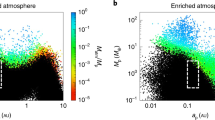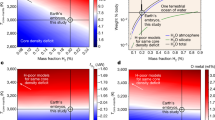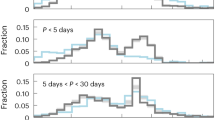Abstract
Efforts to identify habitable extrasolar planets have focused on systems around M dwarfs, faint stars with less than half the solar mass. Habitable planets around M dwarfs are thought to be more plentiful and easier to detect than those orbiting Sun-like G dwarfs1,2,3,4. However, unlike G dwarfs, M dwarfs experience a prolonged decline in luminosity early in their history, leading to an inward migration of the habitable zone to where planets may have lost their water through dissociation and hydrodynamic escape. Water-poor planets, such as Venus, are considered uninhabitable. In contrast, planets with too much water (>1 wt%) would lack continents5, leading to climate instability6 and nutrient limitation problems7. Here we combine a numerical planet population synthesis model with a model for water loss to show that the evolution of stellar luminosity leads to two types of planets of Earth-like mass (0.1 to 10 Earth masses) in the habitable zones around M dwarfs: ocean planets without continents, and desert planets, on which there are orders of magnitude less surface water than on Earth. According to our simulations, Earth-mass planets with Earth-like water contents are rare around M dwarfs and occur 10–100 times less frequently than around G dwarfs. We suggest that stars close to the size of the Sun should be the primary targets for detecting Earth-like planets.
This is a preview of subscription content, access via your institution
Access options
Subscribe to this journal
Receive 12 print issues and online access
$259.00 per year
only $21.58 per issue
Buy this article
- Purchase on Springer Link
- Instant access to full article PDF
Prices may be subject to local taxes which are calculated during checkout


Similar content being viewed by others
Change history
19 February 2015
In the version of this Letter originally published, in Fig. 1, the x axes should have been labelled 'a (au)' and the y axes should have indicated water mass fraction. These errors have been corrected in all versions of the Letter.
References
Howard, A. W. Observed properties of extrasolar planets. Science 340, 572–576 (2013).
Johnson, J. Warm planets orbiting cool stars. Phys. Today 67, 31–36 (March, 2014).
Howard, A. W. et al. Planet occurrence within 0.25 AU of solar-type stars from Kepler. Astrophys. J. Suppl. 201, 15 (2012).
Dressing, C. D. & Charbonneau, D. The occurrence rate of small planets around small stars. Astrophys. J. 767, 95 (2013).
Cowan, N. B. & Abbot, D. S. Water cycling between ocean and mantle: Super-Earths need not be waterworlds. Astrophys. J. 781, 27 (2014).
Abbot, D. S., Cowan, N. B. & Ciesla, F. J. Indication of insensitivity of planetary weathering behavior and habitable zone to surface land fraction. Astrophys. J. 756, 178 (2012).
Dohm, J. & Maruyama, S. Habitable trinity. Geosci. Front. 6, 95–101 (2015).
Hayashi, C. Stellar evolution in early phases of gravitational contraction. Publ. Astron. Soc. Jpn 13, 450–452 (1961).
Di Criscienzo, M., Ventura, P. & D’Antona, F. Updated pre-main sequence tracks at low metallicities for 0.1 ≤ M/M⊙ ≤ 1.5. Astron. Astrophys. 496, 223–227 (2009).
Paxton, B. et al. Modules for experiments in stellar astrophysics (MESA). Astrophys. J. Suppl. 192, 3 (2011).
Tognelli, E., PradaMoroni, P. G. & Degl’Innocenti, S. The Pisa pre-main sequence tracks and isochrones A database covering a wide range of Z, Y, mass, and age values. Astron. Astrophys. 533, A109 (2011).
Kurosaki, K., Ikoma, M. & Hori, Y. Impact of photo-evaporative mass loss on masses and radii of water-rich sub/super-Earths. Astron. Astrophys. 562, A80 (2014).
Ida, S., Lin, D. N. C. & Nagasawa, M. Toward a deterministic model of planetary formation. VII. Eccentricity distribution of gas giants. Astrophys. J. 775, 42 (2013).
Kopparapu, R. K. et al. Habitable zones around main-sequence stars: Dependence on planetary mass. Astrophys. J. Lett. 787, L29 (2014).
Mills, F. P., Esposito, L. W. & Yung, Y. L. in Exploring Venus as a Terrestrial Planet Vol. 176 (eds Esposito, L. W., Stofan, E. R. & Cranvens, T. E.) 73–100 (Geophysical Monograph Series, AGU, 2007).
Owen, J. E. & Jackson, A. P. Planetary evaporation by UV and X-ray radiation: Basic hydrodynamics. Mon. Not. R. Astron. Soc. 425, 2931–2947 (2012).
Hamano, K., Abe, Y. & Genda, H. Emergence of two types of terrestrial planet on solidification of magma ocean. Nature 497, 607–611 (2013).
Lebrun, T. et al. Thermal evolution of an early magma ocean in interaction with the atmosphere. J. Geophys. Res. 118, 1–22 (2013).
Lopez, E. D. & Fortney, J. J. The role of core mass in controlling evaporation: The Kepler radius distribution and the Kepler-35 density dichotomy. Astrophys. J. 776, 2 (2013).
Fox, J. L. Heating efficiencies in the thermosphere of Venus reconsidered. Planet. Space Sci. 36, 37–46 (1988).
Roble, R. G. in The Upper Mesosphere and Lower Thermosphere: A Review of Experiment and Theory Vol. 87 (eds Johnson, R. M. & Killeen, T. L.) 1–21 (Geophys. Monogr. Ser., AGU, 1995).
Koskinen, T. T., Yelle, R. V., Harris, M. J. & Lavvas, P. The escape of heavy atoms from the ionosphere of HD209458b. II. Interpretation of the observations. Icarus 226, 1695–1708 (2013).
Scalo, J. et al. M stars as targets for terrestrial exoplanet searches and biosignature detection. Astrobiology 7, 85–171 (2007).
Ribas, I., Guinan, E. F., Güdel, M. & Audard, M. Evolution of the solar activity over time and effects on planetary atmospheres I. High energy irradiances (1–1700 A). Astrophys. J. 622, 680–694 (2005).
Hayashi, C. Structure of the solar Nebula, growth and decay of magnetic fields and effects of magnetic and turbulent viscosities on the Nebula. Prog. Theor. Phys. Suppl. 70, 35–53 (1981).
Tanaka, H., Takeuchi, T. & Ward, W. R. Three-dimensional interaction between a planet and an isothermal gaseous disk. I. Corotation and Lindblad torques and planet migration. Astrophys. J. 565, 1257–1274 (2002).
Ida, S. & Lin, D. N. C. Toward a deterministic model of planetary formation. VI. Dynamical interaction and coagulation of multiple rocky embryos and super-Earth systems around solar-type stars. Astrophys. J. 719, 810–830 (2010).
Paardekooper, S-J., Baruteau, C. & Kley, W. A torque formula for non-isothermal Type I planetary migration—II. Effects of diffusion. Mon. Not. R. Astron. Soc. 410, 293–304 (2011).
Kretke, K. A. & Lin, D. N. C. The importance of disk structure in stalling type I migration. Astrophys. J. 775, 74 (2012).
Acknowledgements
We thank J. L. Lissauer and I. Pascucci for stimulating discussions. We thank D. S. Abbot for a constructive review. F.T. is supported by the National Natural Science Foundation of China (41175039) and the Startup Fund of the Ministry of Education of China. S.I. is supported by MEXT/JSPS KAKENHI Grant no. 23103005.
Author information
Authors and Affiliations
Contributions
Both authors designed the project. S.I. carried out the planet population synthesis modelling and F.T. carried out the water loss modelling and analysed the data. Both authors wrote the manuscript.
Corresponding author
Ethics declarations
Competing interests
The authors declare no competing financial interests.
Supplementary information
Supplementary Information
Supplementary Information (PDF 293 kb)
Rights and permissions
About this article
Cite this article
Tian, F., Ida, S. Water contents of Earth-mass planets around M dwarfs. Nature Geosci 8, 177–180 (2015). https://doi.org/10.1038/ngeo2372
Received:
Accepted:
Published:
Issue Date:
DOI: https://doi.org/10.1038/ngeo2372
This article is cited by
-
Predicted diversity in water content of terrestrial exoplanets orbiting M dwarfs
Nature Astronomy (2022)
-
Predicting ‘Earth-like’ planets around red dwarfs
Nature Astronomy (2022)
-
An upper limit on late accretion and water delivery in the TRAPPIST-1 exoplanet system
Nature Astronomy (2021)
-
Mineral dust increases the habitability of terrestrial planets but confounds biomarker detection
Nature Communications (2020)
-
Persistence of flare-driven atmospheric chemistry on rocky habitable zone worlds
Nature Astronomy (2020)



